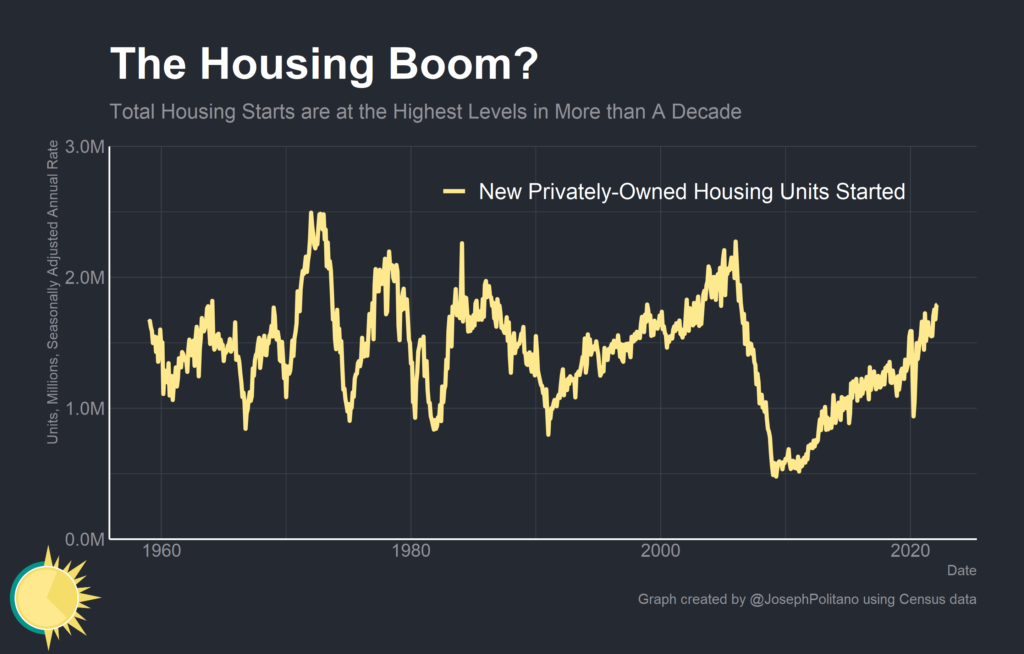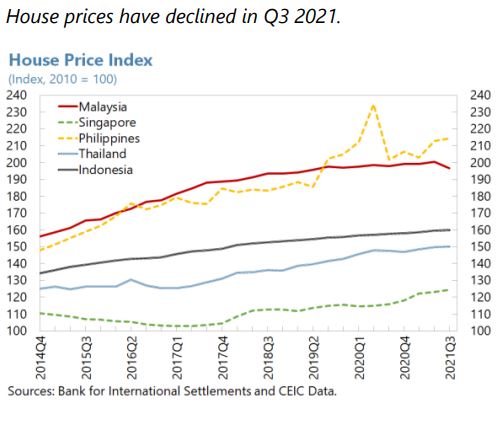Saturday, April 30, 2022
America’s Homebuilding Boom (That Isn’t)
From Apricitas Economics:
“In the years before and after the 2008 recession, American homebuilding completely collapsed. The financial crisis caused housing starts to plummet, and a weak labor market couldn’t support a recovery in rents until 2011. By 2015, though, the problem swapped: weak construction levels couldn’t support a recovery in the labor market. Real rents began climbing rapidly and consistently—something that hadn’t happened before in modern American history.
Today, new housing starts are higher than at any point since early 2006—but it’s nowhere near enough to keep up with population growth, let alone make up for the decade of lost construction. The pandemic has driven increased demand for housing as living patterns shift and incomes improve, but construction is falling behind. Supply chain issues are increasing building costs, keeping housing completions low, and preventing many projects from even breaking ground. Underconstruction has pushed vacancy rates to the lowest levels in nearly 40 years, indicating just how severe the housing shortage has gotten.
There may be a construction boom, but it’s a false boom—one dwarfed by the size of the demand it is trying to satiate. Across America (but especially in major cities), it still remains incredibly difficult or outright illegal to build new housing of any type. More and more Americans are moving into lower cost cities in the South and Southeast, but even these places are failing to keep up. The US will still need millions more homes before demand is even close to satiated—and today’s construction boom needs to be placed in the proper context of an acute housing shortage.”

From Apricitas Economics:
“In the years before and after the 2008 recession, American homebuilding completely collapsed. The financial crisis caused housing starts to plummet, and a weak labor market couldn’t support a recovery in rents until 2011. By 2015, though, the problem swapped: weak construction levels couldn’t support a recovery in the labor market. Real rents began climbing rapidly and consistently—something that hadn’t happened before in modern American history.
Posted by at 1:29 PM
Labels: Global Housing Watch
How the pandemic has changed American homebuyers’ preferences
From The Economist:
“Lifestyle changes had bigger effects. Because city dwellers could not meet face-to-face, they dispersed, mostly to the suburbs. Holding other factors constant, price changes were 10-15 percentage points greater in middling-density counties like Williamson than in big cities or rural areas.
Covid has also led people to spend more time outdoors. In turn, buyers have bid up homes in areas where it seldom rains, summers are balmy or, like Collier, winters are mild. Weather explains 16 percentage points of the gap in price gains between sunny California and frigid Minnesota.
A final factor is remote labour. Before the pandemic, geographic inequality had been rising: areas that were already expensive saw the biggest price gains. In counties that rely on industries, like construction, in which people have to turn up to work, this trend has continued since 2020.
However, the pattern has reversed in areas dominated by industries amenable to remote work, such as finance. Since covid emerged, price gains have been large where housing was previously cheap, and smaller elsewhere. This supports recent research showing that remote workers tend to move to reduce their cost of shelter.”

From The Economist:
“Lifestyle changes had bigger effects. Because city dwellers could not meet face-to-face, they dispersed, mostly to the suburbs. Holding other factors constant, price changes were 10-15 percentage points greater in middling-density counties like Williamson than in big cities or rural areas.
Covid has also led people to spend more time outdoors. In turn, buyers have bid up homes in areas where it seldom rains, summers are balmy or,
Posted by at 8:36 AM
Labels: Global Housing Watch
Friday, April 29, 2022
Housing View – April 29, 2022
On cross-country:
- What’s causing the global rental squeeze? As pandemic restrictions ease, a frenzied scramble for rented property is leading to spiralling prices, bidding wars — and despair – FT
On the US:
- Lessons learned from housing policy during COVID-19 – Brookings
- Another housing bubble? ‘We’re skating close to one,’ says Realtor.com economist – Fortune
- Is the US housing market headed for a price correction? – The Hill
- The odds of a home price decline hitting your local housing market, as told by one interactive chart – Fortune
- Don’t Count On a Housing Slowdown to Improve Affordability. This would be a downturn engineered by the Federal Reserve, and rising mortgage rates in a tight market will generally just make buying a home more expensive. – Bloomberg
- Home Prices Have Begun Falling: Here Are the Cities Where They’re Down the Most – Realtor
- The Hottest Places to Live Now Are Often the Most Affordable. In The Wall Street Journal/Realtor.com Emerging Housing Markets Index, Rapid City, S.D., metro area ranks No. 1 for quarter – Wall Street Journal
- Red Hot Remodeling Growth Expected to Ease into 2023 – Harvard Joint Center for Housing Studies
- U.S. homebuilders to feel pricing pinch from rising mortgage rates, inflation – Reuters
- Pittsburgh Will Force Private Developers To Build Affordable Housing. These “inclusionary zoning” policies have a record of increasing housing costs and suppressing new housing supply. – Reason
- Some Home Buyers Turn to Alternative Financing as Other Options Dwindle. A new study found that even creditworthy shoppers may be unable to find traditional mortgages. But the arrangements often lack typical consumer protections. – New York Times
- Why the Road Is Getting Even Rockier for First-Time Home Buyers. Investors and corporations are buying up houses and turning them into rental properties. In Charlotte, N.C., that is adding to the hurdles facing would-be buyers navigating a brutal market. – New York Times
- It’s Not That Simple: Housing shortage, a review – The Berkshire Edge
- The burgeoning role of ibuyers in the housing market – Real Estate Economics
- Housing demand and remote work – San Francisco Fed
- Redesigning the housing market to build an architecture of equality – Brookings
- Neighborhood Choice After COVID: The Role of Rents, Amenities, and Work-From-Home – NBER
On other countries:
- [Canada] Canada open to more measures to curb housing speculation, minister says – Reuters
- [New Zealand] New Zealand’s cooling housing market means opportunity for some, angst for others – The Guardian
- [New Zealand] NZ cenbank to finalise debt servicing curbs framework for mortgage lending by late 2022 – Reuters
- [Singapore] Singapore Home Prices Grow at Slowest Pace in Almost Two Years. Private home values inched 0.7% higher from previous quarter. Slowdown comes as curbs on property rein in housing boom – Bloomberg
- [Singapore] Singapore’s Housing Shortage Risks Bid to Cool Home Prices. Tight supply, resilient demand may undermine cooling measures. Developers have little incentive to lower prices, analysts say – Bloomberg
- [United Kingdom] House prices, the distribution of household debt and the refinancing channel of monetary policy – IDEAS
- [United Kingdom] U.K. House Prices, Meet the Cost-of-Living Crisis. Britain’s mortgage market is signaling fears of a recession. But big falls in property values look unlikely now that housing is the asset class of the well-off. – Bloomberg
- [United Kingdom] Magic Wandsworth: house prices rise but homes do a disappearing act – FT
On cross-country:
- What’s causing the global rental squeeze? As pandemic restrictions ease, a frenzied scramble for rented property is leading to spiralling prices, bidding wars — and despair – FT
On the US:
Posted by at 5:00 AM
Labels: Global Housing Watch
Thursday, April 28, 2022
Housing demand and remote work
From a new work by John Mondragon (Federal Reserve Bank of San Francisco) and Johannes Wieland (UCSD and NBER):
“What explains record U.S. house price growth during the Covid-19 pandemic? We show that the shift to remote work explains over one half of the 23.8 percent national house price increase over this period. Using variation in remote work exposure across U.S. metropolitan areas we estimate that an additional percentage point of remote work causes a 0.90 percent increase in house prices after controlling for negative spillovers from migration. This cross-sectional estimate combined with the aggregate shift to remote work implies that remote work raised aggregate U.S. house prices by 14.6 percent. Using a model of remote work and location choice we argue that this estimate is a lower bound on the aggregate effect. Our results imply that the evolution of remote work is likely to have large effects on the future path of house prices and inflation.”
From a new work by John Mondragon (Federal Reserve Bank of San Francisco) and Johannes Wieland (UCSD and NBER):
“What explains record U.S. house price growth during the Covid-19 pandemic? We show that the shift to remote work explains over one half of the 23.8 percent national house price increase over this period. Using variation in remote work exposure across U.S. metropolitan areas we estimate that an additional percentage point of remote work causes a 0.90 percent increase in house prices after controlling for negative spillovers from migration.
Posted by at 6:41 AM
Labels: Global Housing Watch
Subscribe to: Posts









